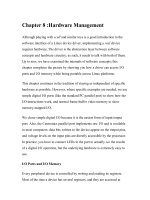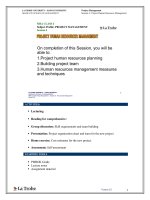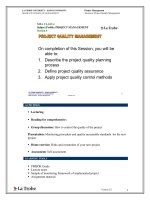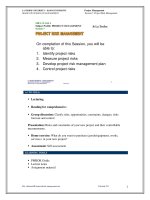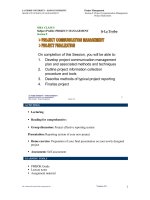Session 8 Development Management
Bạn đang xem bản rút gọn của tài liệu. Xem và tải ngay bản đầy đủ của tài liệu tại đây (1.14 MB, 49 trang )
Principle of Project
Management Fall 2008
1
Software Project Management
Session 8: Development Management
Principle of Project
Management Fall 2008
2
Today
•
Project Roles & Team Structure
•
Group Development
•
Leadership
Principle of Project
Management Fall 2008
3
Project Roles
–
Programmers (system engineers)
•
Technical lead, architect, programmer, Sr. programmer
–
Quality Assurance (QA) engineers (testers)
•
QA Manager, QA Lead, QA staff
–
DBAs
•
DB Administrator, DB Programmer, DB Modeler
–
CM engineers (build engineers)
–
Network engineers, System Administrators
–
Analysts (business analysts)
–
UI Designers
–
Information Architects
–
Documentation writers (editors, documentation specialist)
–
Project manager
–
Other
–
Security specialist, consultants, trainer
Principle of Project
Management Fall 2008
4
Project Roles
•
You need to decide which of these are necessary
for your class project
•
Depends on what you’re building
•
How big is it?
•
Is it UI intensive? Data intensive?
•
Are you installing/managing hardware?
•
Do you need to run an operations center?
•
Is it in-house, contract, COTS, etc?
•
Depends on your budget
Principle of Project
Management Fall 2008
5
Staffing Profile
•
Projects do not typically have a ‘static team
size’
•
Who and how many varies as needed
Copyright: Rational Software 2002
Principle of Project
Management Fall 2008
6
Roll-on & Roll-off
•
PM must have a plan as to how & when
•
Roll-on
–
Hiring or ‘reserving’ resources
–
Ramp-up time
•
Learning project or company
•
Roll-off
–
Knowledge transfer
–
Documentation
–
Cleanup
Principle of Project
Management Fall 2008
7
Staffing Management Plan
•
Part of Software Development Plan
•
Includes
–
What roles needed, how many, when, who
–
Resource assignments
–
Timing: Start/stop dates
–
Cost/salary targets (if hiring)
•
Project Directory
–
Simply a list of those involved with contact info.
•
Team size: often dictated by budget as often as
any other factor
Principle of Project
Management Fall 2008
8
Team Structure
•
1
st
: What’s the team’s objective?
–
Problem resolution
•
Complex, poorly-defined problem
•
Focuses on 1-3 specific issues
•
Ex: fixing a showstopper defect
•
Sense of urgency
–
Creativity
•
New product development
–
Tactical execution
•
Carrying-out well-defined plan
•
Focused tasks and clear roles
Principle of Project
Management Fall 2008
9
Team Models
•
Two early philosophies
–
Decentralized/democratic
–
Centralized/autocratic
•
Variation
–
Controlled Decentralized
Principle of Project
Management Fall 2008
10
Team Models
•
Business Team
–
Most common model
–
Technical lead + team (rest team at equal
status)
–
Hierarchical with one principal contact
–
Adaptable and general
–
Variation: Democratic Team
•
All decisions made by whole team
•
See Weinberg’s “egoless programming” model
Principle of Project
Management Fall 2008
11
Team Models
•
Chief-Programmer Team
•
From IBM in 70’s
–
See Brooks and Mythical Man-Month
•
a.k.a. ‘surgical team’
•
Puts a superstar at the top
–
Others then specialize around him/her
»
Backup Programmer
»
Co-pilot or alter-ego
»
Administrator
»
Toolsmith
»
“Language lawyer”
•
Issues
»
Difficult to achieve
»
Ego issues: superstar and/or team
•
Can be appropriate for creative projects or tactical execution
Principle of Project
Management Fall 2008
12
Team Models
•
SWAT Team
•
Highly skilled team
•
Skills tightly match goal
•
Members often work together
•
Ex: security swat team, Oracle performance team
Principle of Project
Management Fall 2008
13
Team Models
•
Large teams
–
Communication increases multiplicatively
•
Square of the number of people
•
50 programmers = 1200 possible paths
•
Communication must be formalized
–
Always use a hierarchy
–
Reduce units to optimal team sizes
•
Always less than 10
Principle of Project
Management Fall 2008
14
Team Size
•
What is the optimal team size?
•
4-6 developers
–
Tech lead + developers
•
Small projects inspire stronger identification
•
Increases cohesiveness
•
QA, ops, and design on top of this
Principle of Project
Management Fall 2008
15
Responsibility Assignment Matrix
•
A resource planning tool
•
Who does What
•
Can be for both planning and tracking
•
Identify authority, accountability,
responsibility
•
Who: can be individual, team or department
•
Can have totals/summary at end of row or
column (ex: total Contributors on a task)
Principle of Project
Management Fall 2008
16
Simple RAM
Principle of Project
Management Fall 2008
17
Sample RAM With Stakeholders
Principle of Project
Management Fall 2008
18
Skills Matrix
•
Another resource planning tool
•
Resources on one axis, skills on other
•
Skills can high level or very specific
•
Cells can be X’s or numeric (ex: level, # yrs.)
Principle of Project
Management Fall 2008
19
Principle of Project
Management Fall 2008
20
Principle of Project
Management Fall 2008
21
Principle of Project
Management Fall 2008
22
Principle of Project
Management Fall 2008
23
Principle of Project
Management Fall 2008
24
Principle of Project
Management Fall 2008
25
